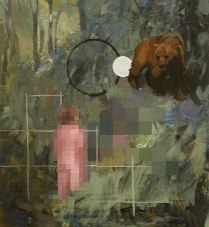
“Mixmaster Universe” at Temple Gallery is a surprising burst of color and exuberance given that its subject is black holes.
That is to say, the show’s not really about black holes but, as part of the Big Nothing festival, it’s a sideways glimpse at science, scientists and scary imploding stars through the eyes and brains of five local artists, David Guinn, M. Ho, Sue Patterson, Roxana Perez-Mendez and Thom Lessner. Temple curator Nancy Lewis, who organized the show, charged the artists with dipping into the John Wheeler Archive on Black Holes at the American Philosophical Society then coming up for air to make a piece of art. It was a good idea and the show’s got some winners.
Out of the cave
Perhaps the oddest tie-in in this colorful, loopy science and art experiment is David Guinn’s paintings featuring a lumbering bear, areas of lush abstraction and a naked caveman who appears digitally blurred like they do on tv for modesty or privacy reasons. (top image is “Guinn’s “Early Times”)
Guinn’s paintings set the scene way back the same way Kubrick, in “2001 Space Oddysey” showed homo erectus discovering fire and tools before blasting into the future.
The idea of ancient man on a quest is a nice touch and one that grounds the show in a kind of historical battle for knowledge and domination.
Guinn, who’s also a Philadelphia muralist (see Libby’s post for more), has other paintings and sculpture in the show but the caveman paintings speak louder about history, chaos and a world that’s a cloudy soup most of the time.
To infinity and beyond
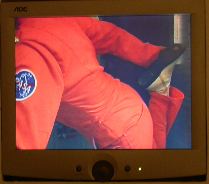
Roxana Perez-Mendez’ “Terra incognita” fast forwards to a space voyage that may be a commentary on our increasingly small and isolated personal existence — or may just be a fantasy about intergalactic travel. Either way, Perez-Mendez’ three-channel video work set in a space capsule presents the artist-astronaut at home reading a magazine; stretching her legs as if warming up for a run; and doing some knee bends in her underwear (a la Sigourney Weaver in Aliens) only here, the Latino artist’s got a crucifix on the wall of her space cabin.
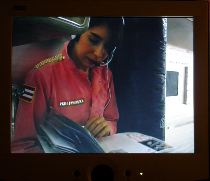
I didn’t see any zero gravity effects but apart from that, the commentary on mundane activities carried out alone in a pod are poignant. I don’t know whether the artist saw Adal Maldonado’s “Coconauts in Space” at Taller Puertorriqueno recently, (read my previous post for more) but I find it interesting that the two Latino artists suited up for space exploration in works about identity, the past and the future.
Black Hole Heroes
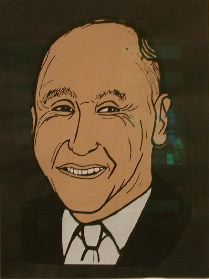
Thom Lessner’s hero worshipful print (shown) depicts a smiling John Wheeler in a four color screenprint. It’s aw shucks wonderful.
Lessner’s “Black Hole Gang,” a black on black screenprint (done in collaboration with Clare Rojas, Andrew Jeffrey Wright and Barry McGee) is laugh out loud funny.
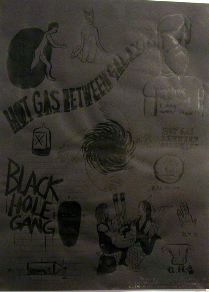
For “Gang,” Lessner and company lay out a mix of symbols, heroes, dudes and words like “My hole is so black I have to wear shades” in what looks like a rock poster. I especially like the artist’s depiction of what looked to me like conjoined twin guitars and elsewhere, two nude men stepping out of a big black hole.
Bouncing balls and pretty packages
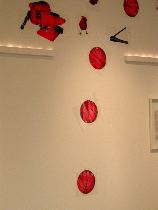
I didn’t quite understand Sue Patterson’s “t” shaped sticker installation on the first floor wall, but I liked the idea of a bouncing ball timeline that runs up a wall and out in both directions with no definable beginning and end (at least it seemed that way to me). Many of the flat cut outs on the wall were red and round and that made a nice symmetry and also started me thinking about whether black holes could be another color…like red.
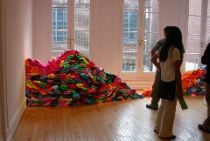
As for speculation of a completely different kind, M. Ho’s installation “All Good News,” which packaged hundreds of daily newspapers in beautiful tissue paper tied with a rubber band, spoke of beautifying things that are ugly or ordinary and about human endeavors to create stability and happiness in a world that’s prone to earthquakes and political upheavals.
Ho has worked with newspapers before. Her piece at the Arcadia works on paper show “prettified” newspaper war stories about Iraq by obliterating the text and leaving the pictures. She’s also made Chinese-type landscape installations from yellow post-it notes. Here, with her mountainous landscape of newspapers, she merges the two streams. It’s a great piece.
Back story
The show’s in conjunction with the Library of the APS, the esteemed local institution that houses the John Archibald Wheeler archives as well as the journals from the Lewis and Clark expedition and lots of other interesting scientific stuff. John Archibald Wheeler, physicist and cosmologist who worked with Albert Einstein, coined the term “black hole” to describe the big, life sucking fields like those created by imploding stars. Wheeler, 93, is professor emeritus at Princeton.
And if you’re wondering about that catchy title, “Mixmaster Universe” (which has a nice rap or hip hop sensibility, the term belongs to physics and was coined by Charles Misner, a student of Wheeler’s. Misner, who didn’t like the idea of the “big bang” theory of the origins of the universe, came up with his theory, the “Mixmaster Universe” which likens the universe’s beginnings to the churnings of a vegetable processor.
By the way, I ran into Lewis at the opening and she said physicist Misner was there looking at the show.
Finally, Bruce Partridge, physicist at Haverford College will give a lecture at the APS titled “The Biggest Nothing” on June 16 at 6:30 pm. Wheeler will be attending the lecture according to Lewis. For more information on the lecture, contact Roy Goodman at the APS at 215-440-3408.









